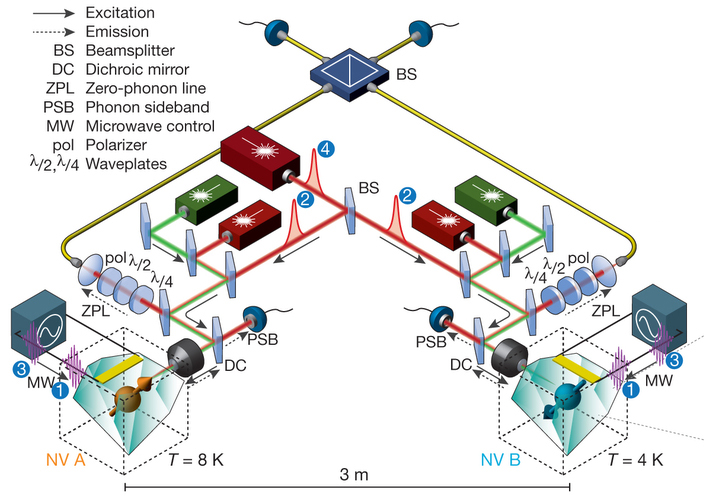Diamond shows promise for a quantum Internet
April 25, 2013

Experimental set-up. Each nitrogen–vacancy (NV) centre resides in a synthetic ultrapure diamond oriented in thedirection. The two diamonds are located in two independent low-temperature confocal microscope set-ups separated by 3 m. The NV centres can be individually excited resonantly by red lasers and off-resonantly by a green laser. The emission (dashed arrows) is spectrally separated into an off-resonant part (phonon sideband, PSB) and a resonant part (zero-phonon line, ZPL). The PSB emission is used for independent single-shot readout of the spin qubits9. The ZPL photons from the two NV centres are overlapped on a fibre-coupled beamsplitter. Microwave pulses for spin control are applied via on-chip microwave striplines. An applied magnetic field of 17.5 G splits the mS = ±1 levels in energy. The optical frequencies of NV B are tuned by a d.c. electric field applied to the gate electrodes (inset, scanning electron microscope image of a similar device). To enhance the collection efficiency, solid immersion lenses have been milled around the two NV centres. (Credit: H. Bernien et al./Nature)
Today’s Internet runs on linked silicon chips, but a future quantum version might be built from diamond crystals, Nature News reports.
Physicists report in Nature that they have entangled information kept in pieces of diamond 3 meters apart, so that measuring the state of one quantum bit (qubit) instantly fixes the state of the other — a necessary step for exchanging quantum information over large distances.
A quantum Internet would use entangled photons traveling down fiber-optic cables to in turn entangle qubits, with the aim of one day providing super-secure communications, or delivering software and data to future quantum computers.
Flawed diamonds
Qubits in diamond depend on imperfections in the materials’ carbon lattice. When nitrogen atoms substitute for carbon atoms, and appear next to gaps, or vacancies, in the structure, a qubit can be created based on the spin state of electrons held in the gap. Their fluorescence gives a faint pink tinge to the crystal.
To entangle qubits in separate pieces of diamond, the team uses lasers to entangle each qubit with a photon at temperatures of 10 kelvin. The photons meet midway through a fiber-optic cable, where they are themselves entangled. A slightly different form of that process was first applied to entangling ytterbium ions in 2007 and neutral rubidium atoms in 2012.
One important goal of the technique is to provide the basis for quantum repeaters, which would make long-distance quantum communications possible.